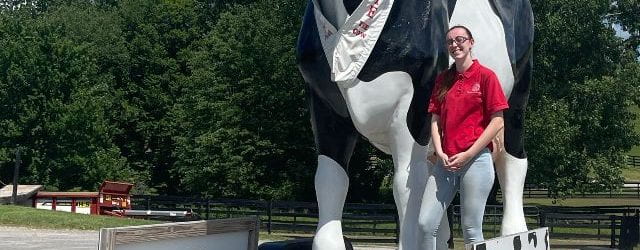
Welcome back to the adventures of my internship! Here is what has happened from the week of June 14th to June 20th:
- So much literature review.
- I met with my faculty advisor Dr. Goodale to go over in detail what the intern from 2019 accomplished
- I learned that the program I’m working on is currently being called the Horse Farm Improvement Program, or HFIP for short
- I found a Cornell Cooperative Extension polo that fits me in the storage closet
- I learned about the history of equine evaluation programs in NY, and how NYSHHAP, the major one, failed because horse owners felt it was too rigid and too focused on evaluation/certification.
- I received my permanent desk/office space for the rest of my internship.
- I read through the AWIN manual for assessing horse welfare on farms.
- I helped Saratogy CCE Equine with their Sundae on the Farm event.
The main highlight of this week was being able to go out and be on a farm during the Sundae on the Farm event. The farm it was located at was a Thoroughbred breeding farm, but they also had cows and sheep. Additionally, King Dairy was there with some dairy ambassadors. The program was set up such that visitors could take a driving tour of the farm and learn about agriculture along the way, and everyone received free ice cream coupons at the end. Farm employees, Cornell Cooperative Extension staff, and volunteers were stationed throughout to answer questions. I was stationed in front of the stallion barn, which was also right next to the giant statue of a cow from King Dairy that was named “Queenie.” Overall, I didn’t end up getting any horse questions. One gentleman asked me what type of cow Queenie was (the answer was Holstein, thank you animal science classes!) and another asked if I could help him reconnect his phone to his car via Bluetooth so he could continue listening to the audio tour. Most of the other questions I received were some variant of, “Which way do I drive now?”
Even if I didn’t get to answer any horse-related questions, it was still a good time. The weather was really nice out, and I was able to watch foals frolicking in a pasture across the road during quiet moments. While I wasn’t technically inspecting any of the facilities, I did look around and try to implement what I had learned from all the literature review I had been doing. It was nice to be able to look around during my time helping out and notice many factors that made the farm a better equine operation. For example, the aisle in the stallion barn was adequately wide and clear of clutter. There was a pond within my view from my spot, and it was blocked off such that horses no horses could enter it. It also had a fountain in it. I realized that beyond serving aesthetic purposes, I realized that it also helped to eliminate standing water. Mosquitoes can breed in standing water and carry diseases, so by eliminating the pond as a source of standing water, the fountain was also helping out with biosecurity!


